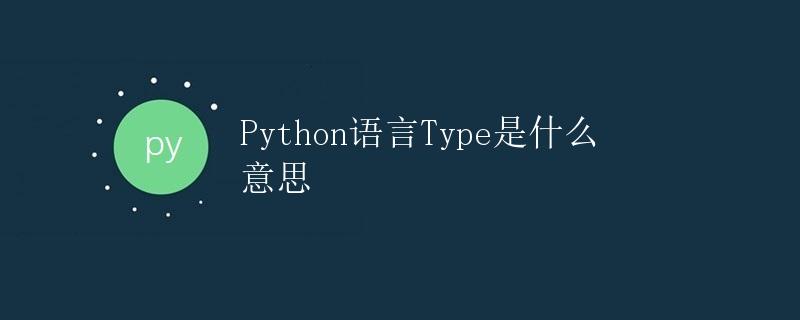Python语言Type是什么意思

一、概述
在Python中,type是一个内置函数,用于获取一个变量的类型。它可以帮助我们了解一个变量究竟是什么类型的对象,从而在编程过程中做出不同的处理。
本文将详细解释type函数的使用方法和相关概念,以及它在实际编程中的应用场景。
二、type函数的语法及用法
type函数的语法如下:
type(object)
其中,object表示要查询类型的对象。
type函数的返回值是一个type对象,它表示对象的类型。
下面是一些常见的示例,以演示type函数的用法。
2.1 查询基本数据类型的类型
print(type(5)) # <class 'int'>
print(type(3.14)) # <class 'float'>
print(type(True)) # <class 'bool'>
print(type('hello')) # <class 'str'>
上述代码中,我们分别使用type函数查询整数、浮点数、布尔值和字符串的类型,并打印出了查询结果。
2.2 查询容器类型的类型
print(type([1, 2, 3])) # <class 'list'>
print(type((1, 2, 3))) # <class 'tuple'>
print(type({'a': 1, 'b': 2}))# <class 'dict'>
print(type({1, 2, 3})) # <class 'set'>
上述代码中,我们分别使用type函数查询列表、元组、字典和集合的类型,并打印出了查询结果。
2.3 查询自定义类的类型
class Person:
pass
class Student(Person):
pass
p = Person()
s = Student()
print(type(p)) # <class '__main__.Person'>
print(type(s)) # <class '__main__.Student'>
上述代码中,我们定义了两个简单的类Person和Student,并创建了两个实例p和s,然后使用type函数查询它们的类型。注意,查询结果中包含了类的名称和命名空间。
三、type函数与isinstance函数的区别
在介绍type函数的特性之前,我们先来了解另一个常用的函数isinstance。isinstance函数用于检查一个对象是否是指定类型的实例。
下面是一个简单的示例,以演示isinstance函数的用法:
x = 5
print(isinstance(x, int)) # True
上述代码中,我们使用isinstance函数检查变量x是否是int类型的实例,并打印出了检查结果。
与isinstance函数相比,type函数的返回结果更加详细。type函数返回的是一个type对象,它包含了对象的具体类型信息,而isinstance函数只返回一个布尔值,表示对象是否是指定类型的实例。
通常情况下,我们可以使用type函数和isinstance函数来进行类型检查。然而,需要注意的是,在涉及到继承关系的情况下,type函数和isinstance函数的行为可能不同。
下面是一个示例,以演示type函数和isinstance函数在处理继承关系时的区别:
class Animal:
pass
class Dog(Animal):
pass
class Cat(Animal):
pass
dog = Dog()
cat = Cat()
print(type(dog) == Animal) # False
print(isinstance(dog, Animal)) # True
print(type(cat) == Animal) # False
print(isinstance(cat, Animal)) # True
上述代码中,我们定义了一个基类Animal,以及两个继承自Animal的子类Dog和Cat。然后,我们创建了一个Dog对象和一个Cat对象,并使用type函数和isinstance函数来判断它们的类型。
注意,在判断dog对象的类型时,type(dog) == Animal的结果是False,因为dog对象的类型是Dog而不是Animal。而isinstance(dog, Animal)的结果是True,因为Dog是继承自Animal的。
四、type函数的应用场景
4.1 检查变量类型
type函数可以帮助我们了解变量的类型,从而在编程过程中做出不同的处理。例如,在处理用户输入时,我们可以使用type函数来检查输入的数据类型是否符合要求。
下面是一个示例,以演示如何使用type函数来检查用户输入的数据类型:
user_input = input("请输入一个整数:")
if type(user_input) == int:
print("输入的是整数")
else:
print("输入的不是整数")
上述代码中,我们首先使用input函数来获取用户输入的数据。然后,我们使用type函数来检查用户输入的数据类型是否为int。如果是,则打印出”输入的是整数”;否则,打印出”输入的不是整数”。
4.2 动态创建对象
在一些特定的场景中,我们可能需要根据输入的数据类型来动态地创建对象。type函数可以帮助我们实现这样的需求。
下面是一个示例,以演示如何使用type函数来动态创建对象:
def create_object(class_name):
return type(class_name, (object,), {})
obj = create_object("DynamicObject")
print(obj) # <class '__main__.DynamicObject'>
上述代码中,我们定义了一个函数create_object,它接受一个类名作为参数,并使用type函数动态地创建一个对象。然后,我们调用这个函数,并打印出了创建的对象。
五、总结
本文详细介绍了Python中的type函数的用法和相关概念。通过type函数,我们可以查询一个变量的类型,并在编程过程中根据不同的类型做出不同的处理。此外,我们还介绍了type函数与isinstance函数的区别,并探讨了type函数在实际编程中的应用场景。
在实际编程中,熟练掌握type函数的使用方法对于开发高效、可靠的程序非常重要。
 极客教程
极客教程